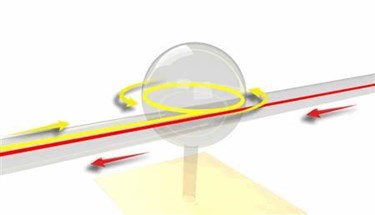Researchers Achieve Complete Optical Isolation In A Fiber Using Light-Sound Interaction
By Jof Enriquez,
Follow me on Twitter @jofenriq

Engineers have strived to create ideal low-loss optical isolators that permit light to pass unimpeded in one direction while absorbing light in the opposite direction. Even though these are considered critical non-reciprocal components for signal routing and protection, integrating them into photonic circuits — such as through the magneto-optic Faraday rotation effect occurring in special gyrotropic materials (e.g., garnet crystals) — faces numerous challenges, such as fabrication difficulty, material losses, and poor control of magnetic fields.
Researchers at the University of Illinois at Urbana-Champaign devised a non-magnetic alternative that can achieve the same level of ultralow-loss complete optical isolation by utilizing a phenomenon called Brillouin Scattering Induced Transparency (BSIT), in which light-sound coupling can be used to slow down, speed up, and block light in an optical waveguide.
As a result, a relatively simpler approach using a opto-mechanical interaction like BSIT can help optical designers build isolators and circulators easily in any photonic foundry process, without relying on magnets or magnetic materials, and regardless of crystallinity or amorphicity of media used, according to a press release.
“In this work, we experimentally demonstrate complete linear optical isolation in a waveguide-resonator system composed entirely of silica glass, by pushing the BSIT interaction into the strong coupling regime, and probing optical transmission through the waveguide in the forward and backward directions simultaneously,” said JunHwan Kim, an engineering graduate student at the University of Illinois.
This approach is most suited for chip-scale cold atom microsystems technologies, for both isolation and shuttering of optical signals, and on-chip laser protection without loss, said the researchers.
“Experimentally, we have demonstrated a linear isolator capable of generating a record-breaking 78.6 dB of contrast for only 1 dB of forward insertion loss within the isolation band,” Kim added in the paper he co-authored with Seunghwi Kim and Gaurav Bahl, which was published recently in Scientific Reports. “This means that light propagating backwards is nearly 100-million times more strongly suppressed than light in the forward direction. We also demonstrate the dynamic optical reconfigurability of the isolation direction.”
Bahl, an assistant professor at the university's department of mechanical science and engineering who earlier co-authored a paper on Brillouin cooling, said that while the team’s experiments demonstrated the effect in a narrow bandwidth, it's possible to achieve wider bandwidth isolation "if the waveguide and resonator are integrated on-chip, since remaining mechanical issues can be eliminated and the interacting modes can be designed precisely."
